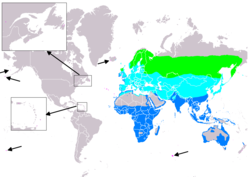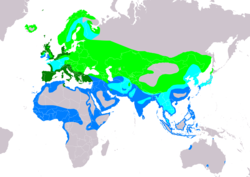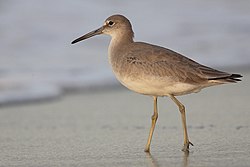| Tringa | |
|---|---|
 | |
| Common greenshank (Tringa nebularia) and common redshank (Tringa totanus) at Cuckmere Haven, Sussex, England | |
| Scientific classification | |
| Kingdom: | Animalia |
| Phylum: | Chordata |
| Class: | Aves |
| Order: | Charadriiformes |
| Family: | Scolopacidae |
| Genus: | Tringa Linnaeus, 1758 |
| Type species | |
| Tringa ochropus (green sandpiper) Linnaeus, 1758 | |
| Species | |
13, see text | |
| Synonyms | |
| |
Tringa is a genus of waders, containing the shanks and tattlers . The genus name Tringa is the Neo-Latin name given to the green sandpiper by the Italian naturalist Ulisse Aldrovandi in 1599. They are mainly freshwater birds, often with brightly coloured legs as reflected in the English names of six species, as well as the specific names of two of these and the green sandpiper. They are typically associated with northern hemisphere temperate regions for breeding. Some of this group—notably the green sandpiper—nest in trees, using the old nests of other birds, usually thrushes.
Contents
- Taxonomy
- Species
- Systematics and evolution
- Fossil record
- See also
- References
- Footnotes
- Cited sources
- Further reading
The willet and the tattlers have been found to belong in Tringa; these genus changes were formally adopted by the American Ornithologists' Union in 2006. [1]
The present genus in the old, more limited sense was even further subdivided into Tringa proper and Totanus , either as subgenera or as full genera. The available DNA sequence data suggests however that neither of these is monophyletic and that the latter simply lumps together a number of more or less closely related apomorphic species. Totanus is not therefore now accepted even as a subgenus. [2]




























